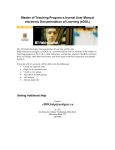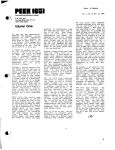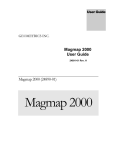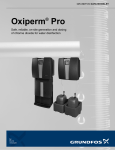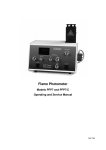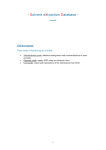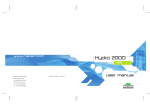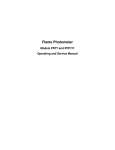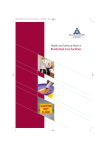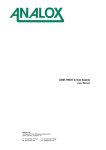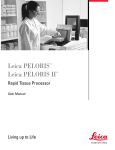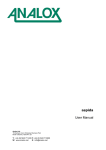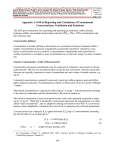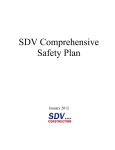Download SOP #1 SAFE WORK PRACTICES
Transcript
1.0 SAFE WORK PRACTICES ........................................................................3 2.0 EMERGENCY RESPONSE .......................................................................5 2.1 Control of Fires ........................................................................................5 2.2 Evacuation procedures during a fire alarm ..............................................6 2.3 Chemical Spill Cleanup Procedures ........................................................7 2.4 Chemical Splash to Eyes .........................................................................7 2.5 Chemical Splash to Skin or Clothing........................................................8 3.0 PERSONAL PROTECTIVE EQUIPMENT....................................................9 4.0 STORAGE, HANDLING AND DISPOSAL OF CHEMICALS ......................10 4.1 Container labeling and MSDS................................................................10 4.2 General Chemical Safety Guidelines .....................................................10 4.3 Hazardous Waste Disposal....................................................................11 5.0 COMPRESSED GAS CYLINDERS............................................................13 5.1 General-Storing and Handling ...............................................................13 5.2 Use of Compressed Gas Cylinders........................................................13 6.0 WORKING ALONE AND AFTER HOURS .................................................15 7.0 CHEMICAL FUME HOODS .......................................................................16 8.0 REFRIGERATORS AND WALK-IN FREEZERS ........................................17 9.0 OVENS AND MUFFLE FURNACES ..........................................................18 10.0 RECIRCULATING BATHS .......................................................................19 11.0 LABORATORY GLASSWARE .................................................................20 12.0 ELECTRIC POWER TOOLS....................................................................21 13.0 HAND TOOLS ..........................................................................................23 14.0 GAS CHROMATOGRAPH .......................................................................24 15.0 HYDROLAB .............................................................................................25 16.0 OHMMAPPER..........................................................................................26 17.0 GEL CELLS (SEALED LEAD ACID BATTERIES) ...................................27 18.0 BATTERY DISPOSAL..............................................................................28 19.0 LASER RANGE FINDER .........................................................................30 20.0 LASER PARTICLE SIZE ANALYZER ......................................................31 21.0 DRIVING A VEHICLE...............................................................................33 22.0 SAFETY IN AND AROUND THE VEHICLE .............................................34 23.0 GENERAL SAFETY IN THE FIELD .........................................................35 24.0 SAFETY WHILE WADING .......................................................................37 25.0 PROTOCOL FOR HANDLING IMPORTED SOIL ....................................38 26.0 TECHNICON BLOCK DIGEST0R ............................................................40 27.0 PICOFLUOR HANDHELD FLUOROMETER ...........................................43 28.0 SORVALL LEGEND T CENTRIFUGE......................................................44 29.0 LABORATORY INSPECTION PROCESS ...............................................47 30.0 CHEMICAL INVENTORY.........................................................................48 31.0 TECHNICON AUTOANALYZER ..............................................................49 32.0 SAFE LIFTING PROCEDURES ...............................................................51 33.0 NOGGIN 500 GROUND PENETRATING RADAR ...................................52 34.0 PAPER SHREDDER ................................................................................53 Safe Work Instructions and Emergency Response Plans 35.0 PAPER CUTTER......................................................................................54 36.0 HALF MASK RESPIRATOR.....................................................................55 37.0 TOC ANALYZER.....................................................................................59 38.0 ION CHROMATOGRAPHY .....................................................................60 Last modified 25 May 07 Safe Work Instructions and Emergency Response Plans 1.0 SAFE WORK PRACTICES Safe work practices are the responsibility of every lab participant. It is the responsibility of each employee and every student to abide by the rules and regulations established by the University of Calgary including any Response Plans, Standard Operating Procedures or additional procedures defined for a specific worksite or procedure. Each lab participant is required to: 1. Use equipment only for its designated use. 2. Become familiar with the location and use of emergency equipment and facilities, such as: eye wash, safety shower, fire extinguishers, fire alarm pull stations, emergency exits and chemical spill equipment. 3. Never eat, drink, smoke, chew gum, apply cosmetics or manipulate contact lens while in the laboratory. 4. Never leave exposed sharps or broken glass on the lab bench. 5. Never leave open containers of caustics, corrosives or toxic substances on the bench. 6. Clearly label all containers of any substance at the worksite following WHMIS regulations. The label must include the name of the substance (not the chemical formula), the concentration and the major health or physical hazard as specified by the MSDS format. 7. Remove personal protective equipment (gloves, lab coats) before leaving the laboratory. Potentially contaminated equipment must be kept where it will not pose a threat to others. 8. Wash your hands after removing gloves and before leaving the laboratory. 9. Remove or obscure hazard labels from cartons, containers or bottles before discarding. 10. Rinse bottles before throwing in garbage. Never throw chemicals into the trash. 11. Place clean broken glassware in appropriate container under sink in ES 905. 12. Wear appropriate clothing in the lab. Open-toed shoes, bare legs or shorts are not permitted. 13. All University employees, research assistants or students who might work alone (e.g. graduate students) must take a site specific WHMIS course before working with hazardous materials or in laboratory where others use hazardous materials. 14. Laboratory doors should be locked if no one is present. This is a fire and safety issue. 15. Unauthorized individuals must not be allowed in the laboratory. Authorized means having business in the laboratory with the permission of the laboratory supervisor. These persons must be made aware of the hazards and provided with the same protection from hazards as others Last modified 25 May 07 Safe Work Instructions and Emergency Response Plans working in the laboratory. Anyone under the age of 18 must be under the immediate supervision of a qualified authorized person at all times. 16. Use mechanical devices for all pipetting procedures; never pipet by mouth. 17. Be alert to unsafe conditions and call attention to them so corrections can be made. 18. Consider any unlabeled chemical solution to be hazardous until indentified. 19. Place warning labels on hot surfaces. 20. Make sure floors and passageways are free of hazards. 21. Keep clear two passageways to exit doors. 22. Clear space around eyewashes, safety showers and fire extinguishers. 23. Avoid horseplay, practical jokes and other acts of carelessness. Last modified 25 May 07 Safe Work Instructions and Emergency Response Plans 2.0 EMERGENCY RESPONSE Type Emergency Medical Emergencies of Who to Call Fire Chemical Spill Bomb threat Suspicious person Altercation Directions/Procedures Campus Security Campus security will assist, contact 220-5333 (24 hrs) EMS and direct them to your location. EASC and ENSC technologists are trained in First Aid. Pull fire alarm Proceed to the nearest stairwell. DO (located in NOT use elevators or stairwell by hallway by each elevators. Once outside move away centre stairwell or from the exit and do not reenter unless in the elevator instructed to do so. foyer). Call 911. Campus Security Environmental Health and Safety will 220-5333 (24 hrs) arrange for help with spill clean up or provide advice on proper clean up procedures Campus Security 220-5333 (24 hrs) 2.1 Control of Fires 1. Know the location of all fire extinguishers and fire pull alarms. 2. A small fire may be extinguished using a fire extinguisher. Remember R.A.C.E. Rescue – First clear people from the lab Announce – Call 911 and activate the fire alarm. Contain the fire by closing doors. Extinguish the fire only after calling 911, activating the fire alarm and only if you are competent it can be done quickly and successfully. 3. To use a fire extinguisher remember P.A.S.S. Pull safety pin from handle. Aim nozzle at base of fire. Squeeze trigger handle. Sweep from side to side and watch for reflash. When using an extinguisher, always stand between the fire and the exit. Do not underestimate fires and remember that toxic gases and smoke provide additional hazards. Last modified 25 May 07 Safe Work Instructions and Emergency Response Plans 4. In the event of a more serious fire, evacuate the lab, activate the nearest alarm and call 911. 5. Personal injuries can result from fires. If a person’s clothing catches fire, they should STOP, DROP and ROLL. 2.2 Evacuation procedures during a fire alarm 1. 2. 3. 4. Respond to fire alarms and strobe lights by evacuating your area. Take your personal belongings only if they are within reach. Close all doors behind you. The fire wardens assigned to the Earth Science 9th floor will ensure that all persons in the area will have received the alarm. 5. If you discover a fire, activate the nearest fire alarm pull station and proceed to nearest safe exit. Do not use the elevators or the stairwell between the elevators. Only the centre stairwells (marked in red below) are fire rated. 6. Once outside, move away form the exit and do not reenter the building until instructed to do so by the City of Calgary Fire Department, Campus Security, Environmental Health and Safety personnel or the Emergency Warden. Last modified 25 May 07 Safe Work Instructions and Emergency Response Plans 2.3 Chemical Spill Cleanup Procedures The spill kit is located under the centre bench across from the sink in ES 905. A successful spill clean up is one in which no one gets exposed or injured during the clean up. DON'T RUSH, DON'T WORK ALONE, AND DON'T CLEAN UP A SPILL UNTIL YOU ARE FAMILIAR WITH THE PROPERTIES OF THE CHEMICAL *Remember to check the MSDS (Material Safety Data Sheet) prior to cleaning up any chemical. 1. Warn personnel in the laboratory. If a volatile, flammable, or highly toxic material is spilled, have everybody extinguish flames and turn off spark-generating equipment and evacuate the laboratory immediately. 2. If clothing is contaminated, remove it and use the emergency shower to rinse the affected areas. If contaminates are in your eyes rinse for at least 15 minutes at an eyewash station. Seek medical attention. 3. If there are medical emergencies call Campus Security at 220-5333 for an ambulance. Provide the following information: • Your name and phone extension. • Exact location of spill (building and room number). • Name of material spilled. • Quantity of material spilled. • Information on injuries to personnel. 4. Obtain the required spill supplies, put on appropriate protective equipment. 5. If non-toxic, non-volatile, non-flammable material is spilled, start to place absorbent materials at the edge of the spill. 6. Always pour the neutralizer or absorbent starting at the edges and moving toward the center of the spill site. 7. Scoop up all absorbed material. Remember, if no neutralizer was used, the absorbed material is still hazardous. 8. Neutralize any residue you are unable to pick up with appropriate absorbent. 9. Wash the affected area with an appropriate cleaning solution (soap and water). 10. Report the spill to your Supervisor. Complete a Campus Incident / Illness Report. 11. Dispose of all cleanup materials as hazardous waste. 2.4 Chemical Splash to Eyes 1. Get to the eye wash station (ES 905) or any source of water immediately and wash the eye out thoroughly with copious amounts of water. Hold the eye open to wash thoroughly behind the eyelid. Last modified 25 May 07 Safe Work Instructions and Emergency Response Plans 2. In the absence of an eyewash fountain, place injured person on his/her back and pour water gently into the eye. The injured eye must be held open. 3. Continue washing for at least 15 minutes. 4. Seek medical help by calling Campus Security at 220-5333. 2.5 Chemical Splash to Skin or Clothing 1. Get to the safety shower immediately (ES 905). 2. Quickly remove all contaminated PPE and clothing WHILE USING THE SHOWER! 3. Flood the affected body area with COLD water for at least 15 minutes. The safety shower dumps a preset volume of water once the pull cord has been activated. 4. Seek medical help by calling Campus Security at 220-5333 Associated SAFE WORK INSTRUCTIONS 1. Personal Protective Equipment 2. Safe Work Practices 3. Storage, Handling and Disposal of Chemicals Last modified 25 May 07 Safe Work Instructions and Emergency Response Plans 3.0 PERSONAL PROTECTIVE EQUIPMENT 1. Safety glasses, protective gloves, lab coats and splash guards are provided in the lab. 2. Safety glasses are located on the shelf above the balance in ES 923 and under the fire extinguisher in ES 905. 3. A selection of protective gloves (latex and/or nitrile) is located on the shelf to the right of the sink in both labs. Ensure that the type of glove you are wearing is a suitable protectant for the chemical you are using. 4. The splash guard is located on top of the general chemical storage area in ES 905. 5. Lab coats are provided on coat racks in both labs in case you have forgotten one or do not have your own lab coat. 6. Since the walk-in freezer is set to temperatures as cold as -20ºC, it is necessary to wear cold weather clothing when working inside. With the wind chill from the fans, temperatures are likely to seem colder. If you know you will be working in the freezer, please bring your own gear. There is one set hanging on the coat rack in the ES 923A should you forget your own. 7. When handling samples, crucibles, glassware or other items that have been placed in the oven, use tongs and/or heat resistant gloves to protect your hands. Always wear safety glasses. 8. When removing samples from the muffle furnace, allow the items to cool in the furnace before attempting to remove them. Use heat resistant gloves and/or tongs to remove the samples. Never place warm samples directly on the bench as the countertops are not heat resistant. There are heat resistant bricks located on the side of the furnace to place your samples on when they come out of the furnace. 9. Respirators are provided for the use of the EASC or ENSC technicians only and are kept in their respective offices. They are custom fit for their use only. Last modified 25 May 07 Safe Work Instructions and Emergency Response Plans 4.0 STORAGE, HANDLING AND DISPOSAL OF CHEMICALS Hazard Review Noxious Fumes and Vapors Volatile Liquids Unknown Vapors Chemical Agents 1. Chemicals must be stored according to chemical class. 2. Date containers (month/day/year) when received. 3. Chemical storage should be kept to a minimum by storing only for immediate needs. 4. Prior to working with a new chemical, always read the MSDS. 5. Personal protective equipment (PPE) must be worn when working with chemicals. 6. Keep eyewashes and showers, fire extinguishers, fire alarm stations, and exits clear. 7. Never eat, drink, chew gum, apply cosmetics, or wear open-toed shoes in the laboratory. 8. Remove PPE, including gloves, and wash hands before entering common areas. 9. Chemical spill kits must be readily available. 10. Laboratory doors must be kept closed at all times if no one is in the lab. 11. Ensure chemicals are properly labeled and dated (when received). 12. Do not use equipment unless you have been properly trained in its use. 13. Use practices and equipment that minimize hazards. 4.1 Container labeling and MSDS All chemicals must be labeled according to WHMIS rules and regulations. Before working with a chemical, read the MSDS. Links to MSDS information are found on the computer by the Particle Size Analyzer in ES 905. The sign-on password is taped to the CPU. Click on the MSDS icon on the desktop. The chemicals are listed alphabetically. Clicking on the name of the chemical will link to the vendor MSDS . 4.2 General Chemical Safety Guidelines 4.2.1 Acids 1. Store large bottles of acids on low shelves or in acid cabinets. Last modified 25 May 07 Safe Work Instructions and Emergency Response Plans 2. Segregate oxidizing acids from organic acids, flammable and combustible materials. 3. Segregate acids from bases. 4. Use bottle carriers for transporting acid bottles. 5. Have spill control pillows or acid neutralizers available in the event of a spill. 4.2.2 Bases 1. Segregate bases from acids. 2. Store large bottles of liquid bases on trays in a cabinet marked “Bases”. 3. Have spill control pillows or caustic neutralizers available for caustic spills. 4.2.3 Flammables 1. Only store flammable liquids in a specially equipped explosion proof refrigerator or flammables cabinet. 2. Store in approved safety containers in approved cabinets. 3. Keep away from sources of ignition. 4. Keep fire extinguishing and spill control equipment readily available. 4.2.4 Oxidizers 1. Store in a cool, dry area 2. Store away from flammable and combustible materials, such as paper, wood, etc. 4.2.5. Compressed Gases 1. Store in a secure and upright position. Chain individually, 2/3 to 3/4 from the floor up. 2. Indicate: Full or In Use or Empty. 3. When not in use, replace cylinder cap. 4. To transport use a cylinder cart; remove all manifolds, secure cap, and chain tank to cart 4.3 Hazardous Waste Disposal 1. Select a suitable container for the material being disposed. 2. Document and clearly list the contents of the container on the waste sheet attached to the container. 3. Complete the appropriate waste forms. Chemicals must be identified with their chemical name, not chemical formula. Amounts and concentrations must be noted. Last modified 25 May 07 Safe Work Instructions and Emergency Response Plans 4. All waste containers must be free from contamination and spills. 5. Do not fill bottles past the shoulder of the bottle. 6. EASC or ENSC technologists will call for hazardous pickup as necessary. 7. On pickup day, containers must be easily assessable. Associated SAFE WORK INSTRUCTIONS 1. 2. 3. 4. Safe Work Practices Personal Protective Equipment Chemical Fume Hoods Emergency Response Last modified 25 May 07 Safe Work Instructions and Emergency Response Plans 5.0 COMPRESSED GAS CYLINDERS Hazard Review High Pressure Gases Crushing Injuries Flammable Gases Explosion 5.1 General-Storing and Handling 1. Supervisors shall verify that operators are trained, capable and qualified in the use of compressed gas cylinders before allowing them to be operated. 2. Do not handle oxygen cylinders while wearing greasy or oily gloves. 3. Store all compressed gas cylinders in the upright position. 4. Place valve protection caps on compressed gas cylinders that are in storage and are not being used. 5. Do not lift compressed gas cylinders by the valve protection cap. 6. Store compressed gas cylinders in areas where they will not come in contact with corrosive chemicals or corrosive mists. 7. Do not place compressed gas cylinders against electrical panels or live electrical cords where the cylinder can become part of the circuit. 8. Use a cylinder cart to move cylinders. Secure cylinder to cart before moving. 5.2 Use of Compressed Gas Cylinders 1. Operators shall perform a pre-operational check of all air hoses, couplings and connections to determine if leakage or other damage exists. Be familiar with operator's manual. Do not operate unsafe equipment. 2. Wear appropriate personal protective equipment consistent with hazard and job task. 3. Do not use dented, cracked or other visibly damaged cylinders. 4. Only use an open ended or adjustable wrench when connecting or disconnecting regulators and fittings. 5. Do not transport cylinders without first removing the regulators and replacing the valve protection caps. 6. Close the cylinder valve when work is finished, when the cylinder is empty or at any time the cylinder is moved. 7. Do not store oxygen cylinders near fuel gas cylinders such as propane or acetylene, or near combustible material such as oil or grease. 8. Stand to the side of the regulator when opening the valve. 9. Do not use compressed gas to clean yourself, equipment or work area. Last modified 25 May 07 Safe Work Instructions and Emergency Response Plans 10. Open cylinder valves slowly. In order to eliminate possible leakage around the cylinder valve stem, open valves fully when the compressed gas cylinder is in use. Associated SAFE WORK INSTRUCTIONS 1. 2. 3. 4. 5. Safe Work Practices Personal Protective Equipment Hand Tools Emergency Response Storage, Handling and Disposal of Chemicals Last modified 25 May 07 Safe Work Instructions and Emergency Response Plans 6.0 WORKING ALONE AND AFTER HOURS Hazard Review Electrical Medical emergency Noxious fumes and vapours Tripping and Falling Fire/Explosion Chemical agents Volatile liquids 1. Do not work alone/after hours without prior approval from the principal investigator. Inform the technician when you will be working and what you will be working with. 2. Working alone where the work has a high potential hazard is strictly prohibited (for example: working with concentrated acids, highly toxic chemicals, open flames). 3. If you must work after hours, you must either work in pairs or institute a regular call out system with another individual. If this individual does not hear from you within a reasonable time, they must call Campus Security at 220-5333. Associated SAFE WORK INSTRUCTIONS 1. 2. 3. 4. Safe Work Practices Personal Protective Equipment Emergency Response Storage, Handling and Disposal of Chemicals Last modified 25 May 07 Safe Work Instructions and Emergency Response Plans 7.0 CHEMICAL FUME HOODS Hazard Review Noxious Fumes and Vapors Volatile Liquids Unknown Vapors Limited Space Chemical Agents Poor Ventilation 1. Verify exhaust system is operating before working in the hood. Monitor the dial to verify continued operation. Normal operating pressure is 0.1 Pascal. 2. Procedures which involve the liberation of volatile, flammable or toxic materials must be performed in a fume hood. 3. Work well inside the hood: minimally, 6 inches from the face. 4. Maintain a sash height as feasible within the guidelines of the inspection for the manipulations performed 5. Do not block the air exit slots at the lower rear of the hood 6. Large equipment in the hood creates potentially dangerous zones of turbulence. If this use is necessary, the hood should be so dedicated and not used for other purposes. 7. Keep your head outside the fume hood. 8. Do not overcrowd or clutter the fume hood. 9. Do not store chemicals in the fume hood. Associated SAFE WORK INSTRUCTIONS 1. 2. 3. 4. Safe Work Practices Storage, Handling and Disposal of Chemicals Personal Protective Equipment Emergency Response Last modified 25 May 07 Safe Work Instructions and Emergency Response Plans 8.0 REFRIGERATORS AND WALK-IN FREEZERS Hazard Review Cold temperatures Ventilation Confined spaces Working Alone Slipping and Falling Walk-In Freezer 1. No flammable liquids or gases can be stored in this room. This includes Liquid Nitrogen and Dry Ice. 2. Take care when entering the walk-in freezer as there may be ice on the floor and you may slip and fall. 3. If the freezer door is left open for more than 45 seconds an auditory alarm will sound and phone out alarm will also be sent. Closing the door will silence the alarm. 4. You cannot be locked inside the freezer. Push on the mushroom shaped door handle on the inside to release the lock. This emergency release will work even if the freezer is locked. 5. The freezer may be set to temperatures as low as -20ºC and there is a wind-chill from the compressor fans. Dress in winter gear before working in the freezer. Hypothermia may result if you work in the freezer without proper clothing. Take special care to protect your hands and face. 6. Do not work in the freezer without alerting others to your whereabouts and the approximate time that you will be inside. Develop a “buddy” system so that someone will check on you if you do not come out of the freezer in a reasonable amount of time. 7. No food and/or beverages for human consumption may be stored in the Walk-in Freezer. Refrigerators 1. Special care is necessary to ensure protection from explosion or fire when storing chemicals in a refrigerator. Only “explosion-proof” refrigerators can be used to store flammable chemicals. Sparking in regular units can ignite and explode fumes. None of the refrigerators in ES 923 or 905 is rated as explosion proof so no flammable chemicals should be stored in them. 2. No food and/or beverages for human consumption may be stored in the laboratory refrigerators. Associated SAFE WORK INSTRUCTIONS 1. 2. 3. 4. Safe Work Practices Working Alone and After Hours Personal Protective Equipment Emergency Response Last modified 25 May 07 Safe Work Instructions and Emergency Response Plans 9.0 OVENS AND MUFFLE FURNACES Hazard Review Electrical Shock Explosion hazard Hot surfaces Burns Harmful vapour Ovens 1. Neither of the ovens in ES 923 are explosion proof. Do not place combustible or flammable materials in the ovens as a fire or explosion may result. 2. Fumes and spillage from acidic solutions cause corrosion of the stainless chamber. Care should be taken to maintain a neutral pH at all times. 3. Wear insulated gloves when reaching into a heated oven or handling hot samples. 4. Use heat resistant gloves when reaching inside a hot oven or when removing your samples from a hot oven. 5. Use tongs to remove your samples from the oven. 6. Never stand in front of an open oven. 7. Never place hot samples on the bench tops. Cool samples in the oven prior to removing them. 8. Never place samples directly on the bottom of the oven; use only the racks provided. Muffle furnace 1. Make sure the ventilation hood is over the top vent. Turn on the ventilation (slider switch on front of fume hood) prior to turning on the oven. 2. Cool your samples in the furnace before removing them. 3. Remove samples with tongs. 4. Wear heat resistant gloves when reaching inside a hot furnace or when removing your samples from a hot furnace. 5. Never place hot samples on the bench top. 6. Place hot samples on the heat resistant bricks provided. 7. Use tongs to remove samples from the furnace. 8. Never stand directly in front of a heated furnace. Avoid placing your head or unprotected hands near the oven. 9. Place samples inside the furnace only on the porous ceramic plates or shelf and never directly on the bottom of the furnace. 10. Turn on the venting system when the furnace is in operation. Associated SAFE WORK INSTRUCTIONS 1. Safe Work Practices 2. Emergency Response 3. Personal Protective Equipment Last modified 25 May 07 Safe Work Instructions and Emergency Response Plans 10.0 RECIRCULATING BATHS Hazard Review Electrical Shock Temperature Extremes Chemical agents 1. Do not place hands inside the circulator when the pump is running. 2. Do not fill the tank with Antifreeze that contains additives, bleach, concentrated acids or bases, or any flammable liquids. 3. When refrigeration is switched off, it should not be restarted for approximately 10 minutes to allow the internal pressures to equalize. System damage could result if this waiting period is not observed. 4. The tanks are filled with 1:1 antifreeze: water unless otherwise specified. Read the MSDS for antifreeze (ethylene glycol) prior to using the recirculator. 5. Wear safety glasses and wear protective gloves when handling the antifreeze. Associated SAFE WORK INSTRUCTIONS 1. 2. 3. 4. Safe Work Practices Emergency Response Personal Protective Equipment Storage, Handling and Disposal of Chemicals Last modified 25 May 07 Safe Work Instructions and Emergency Response Plans 11.0 LABORATORY GLASSWARE Hazard Review Sharp edges Cuts and Abrasions Improper equipment 1. 2. 3. 4. Wear safety glasses at all times. All glassware must be used only for its intended purpose. All glassware will be handled and stored with care to minimize breakage. All clean broken glass must be disposed into the broken glassware container under the sink in ES 905. 5. When cleaning up broken glass, wear protective gloves to avoid cuts. Associated SAFE WORK INSTRUCTIONS 1. Safe Work Practices 2. Personal Protective Equipment Last modified 25 May 07 Safe Work Instructions and Emergency Response Plans 12.0 ELECTRIC POWER TOOLS Hazard Review Electrical Shock Dust Flying particles Noise Sharp Edges and Points Cuts and Abrasions Pinch Points Improper Tool When working with power tools, basic safety precautions must always be followed to mitigate the risk of fire, electrical shock and personal injury. 1. Employees should be thoroughly trained before attempting to use any power tool. Read all the instructions for the specific tool including application, operating limitations and potential hazards of each before attempting use. 2. Keep work area clean and uncluttered. 3. Avoid dangerous environments. Do not expose power tools to rain or use in wet or damp locations. Use only in well lit areas. Do not use in the presence of flammable liquids or gases. 4. Guard against electrical shock. Prevent body contact with grounded surfaces. 5. Keep untrained persons away from work area. 6. Store idle tools in the storage room in ES 905. The door to this storage area will remain locked when unattended. 7. Do not force the tool. It will do a better job at the rate for which it was intended. 8. Use the right tool. Do not use a tool for a use for which it was not intended. 9. Dress properly. Do not wear loose clothing or jewelry that could become caught in moving parts. Pull back long hair. 10. Use safety glasses. All persons in the area where power tools are used must also wear safety glasses. 11. Don’t abuse the electrical cord. Never carry tool by cord or yank it to disconnect from the electrical receptacle. Keep cord away from heat, oil, and sharp edges. Replace worn or damaged cords. Never use a power tool with a damaged cord. 12. Secure work. Use clamps or vise to hold work. It is safer than using your hand and it frees up both hands to operate the tool. 13. Don’t over reach. Keep proper footing and balance at all times. 14. Maintain tools. 15. Disconnect tools when not in use, before servicing and when changing accessories such as blades, bits, cutters etc. Last modified 25 May 07 Safe Work Instructions and Emergency Response Plans 16. Avoid unintentional starting. Be sure switch is off when plugging in. Keep hands, body and clothing clear of blades, bits, cutters etc. when plugging in. 17. Stay alert, watch what you are doing and use common sense. Do not operate tool when you are tired, or under the influence of medication, alcohol or drugs. 18. Check for damaged parts and report damage to EASC or ENSC technologist. Do not attempt to use a tool that has damaged parts. 19. Wear ear protection to safeguard against hearing loss. Ear plugs and/or ear muffs are available in ES 905. 20. Tools with sharp edges will be guarded and handled to avoid injury. 21. Do not interrupt a person who is using a power tool. An interruption takes away their concentration from safe procedures and may cause a serious injury. Associated SAFE WORK INSTRUCTIONS 1. Safe Work Practices 2. Personal Protective Equipment Last modified 25 May 07 Safe Work Instructions and Emergency Response Plans 13.0 HAND TOOLS Hazard Review Pinch Points Dust Flying particles Improper Tool Sharp Edges and Points Cuts and Abrasions 1. Use the right tool. Do not use a tool for a use for which it was not intended 2. Hammers with metal handles, screwdrivers with metal continuing through the handle and metallic measuring tapes shall not be used on or near energized electrical current or equipment. 3. Tools shall not be thrown from place to place or from person to person. 4. Tools shall never be placed unsecured on elevated places. 5. Wrenches with sprung or damaged jaws shall not be used. 6. Tools with sharp edges shall be stored and handled so that they will not cause injury. 7. Tools with wooden handles that are loose, cracked or splintered will be replaced. The handle shall not be taped or lashed with wire. 8. Tools shall not be left lying around where they might cause a tripping hazard. 9. Eye protection must be used at all times with using hand tools. 10. Never attempt to use a sledgehammer at or above shoulder height. 11. Shovels must never be left lying around with blades in an upright position. Blades, when stepped upon, may cause the handles to fly up and strike you in the face. 12. Long-handled tools must be placed in an upright position when not in use. 13. Pliers must not be used as a substitute for wrenches as they do not hold the work securely and injury may result from slipping. 14. Screwdrivers must not be used as substitutes for punches, hammers, wedges, or similar. Associated SAFE WORK INSTRUCTIONS 1. Safe Work Practices 2. Personal Protective Equipment Last modified 25 May 07 Safe Work Instructions and Emergency Response Plans 14.0 GAS CHROMATOGRAPH Hazard Review Explosive Gases Electric Shock Toxic Vapours Asphyxiation Open Flame 1. Be familiar with the operating instructions set forth in the operators manual for the particular GC you are using and follow all manufacture guidelines. 2. Prior to use, perform a check of the GC and ensure that all parts are intact and properly functioning. 3. The column must be connected to the detector before igniting the flame. 4. Always be aware that flame ionization detector (FID) gases (hydrogen and air) form explosive mixtures. All gas connections must be properly leak tested at installation. 5. High-pressure compressed-gas cylinders must be secured to the wall and chained in place or held with a cylinder clamp. 6. When it is necessary to perform maintenance on the GC, the detector gases shall be shut off. 7. The detectors and injectors are kept at a very high temperature and can cause burns when touched. Before working on the detectors or injectors, turn the detector or injector ovens off and allow the detectors or injectors to cool first. 8. Avoid high voltage sources inside the GC. Before removing any external covers, unplug the GC from the electrical outlet. Be sure that any residual current in capacitors has discharged before touching any component of an internal circuit. Work with one hand, using plastic coated tools, and keep the other hand in the air and away from your body to prevent creating a circuit through your heart. Associated SAFE WORK INSTRUCTIONS 1. 2. 3. 4. Safe Work Practices Personal Protective Equipment Emergency Response Storage, Handling and Disposal of Chemicals Last modified 25 May 07 Safe Work Instructions and Emergency Response Plans 15.0 HYDROLAB Hazard Review Blunt injury Slipping and falling Electrical shock Drowning 1. Read and understand the Hydrolab manual before attempting use. 2. To avoid potential fatal electrical shock and/or instrument damage, avoid using AC current to power the probe. Use battery power with a combined voltage not to exceed 15 volts. 3. When loosening removable parts from the probe, always point those parts away from your body and other people. In extreme conditions, excess pressure may build up inside any underwater housing, causing the caps, sensors, or other removable parts to disengage with force sufficient to cause serious injury. 4. The probe maximum immersion depth is 225 meters (738 feet). To protect the 1-10 and 0-25 meter depth sensors, install the depth’s seal screw in the face of the multiprobe sensor cap. 5. Water can get trapped between the multiprobe battery cap contact surface and the top of the multiprobe compartment 0-rings. To avoid water leaks into the battery compartment during maintenance or replacement, place the multiprobe horizontally on the work surface when removing the batter cap. To avoid water contact with the multiprobe internal components during battery replacement, avoid replacing batteries near any water source. 6. If water leaks into the battery component, remove the batteries, pour the water out and thoroughly dry the compartment with a towel. Then install new batteries. 7. Be cautious on river and stream banks. The rocks may be slippery. Associated SAFE WORK INSTRUCTIONS 1. 2. 3. 4. Safe Work Practices Working in the Field Driving a Vehicle Water Safety Last modified 25 May 07 Safe Work Instructions and Emergency Response Plans 16.0 OHMMAPPER Hazard Review Electrical shock 1. Read and understand the OhmMapper manual before attempting use. 2. The transmitter can generate up to 1000 Volts AC at current levels of 16 mA. This can be dangerous under certain circumstances. 3. All batteries should be charged after each use. Write the date of charging on the label. Associated SAFE WORK INSTRUCTIONS 1. Safe Work Practices 2. Gel Cells 3. Battery Disposal Last modified 25 May 07 Safe Work Instructions and Emergency Response Plans 17.0 GEL CELLS (SEALED LEAD ACID BATTERIES) Hazard Review Inhalation of dangerous vapours Burns Exposure to dangerous chemicals 1. Gel cells have the potential to be dangerous if not properly installed, maintained or charged. 2. Store cells in a dry ventilated area. 3. Charge batteries in a well ventilated area. 4. Keep battery clear of oxidizers and solvents. 5. Use gloves and safety glasses when working with cells 6. Do not overcharge battery. The charging procedure produces hydrogen gas which is recombined into the electrolyte under normal circumstances. Overcharging the battery can rupture the case and cause exposure to hydrogen gas, lead, lead dioxide, lead sulfate and sulfuric acid. 7. Avoid electrically shorting the battery. 8. If cell ruptures, flush with copious amounts of lukewarm water for a minimum of 15 minutes. Get immediate medical attention for eyes. Wash skin with soap and water. Remove all contaminated clothing. 9. Batteries must be recycled. Associated SAFE WORK INSTRUCTIONS 1. 2. 3. 4. Safe Work Practices Emergency Response Battery Disposal Personal Protective Equipment Last modified 25 May 07 Safe Work Instructions and Emergency Response Plans 18.0 BATTERY DISPOSAL Hazard Review Hazardous chemicals All batteries that are considered to be hazardous waste must be collected for pickup by Environment Health and Safety Services. Place all batteries for disposal in the plastic tray under the fume hood in ES 905. 1. Alkaline batteries are disposable or non-rechargeable batteries. They are often GPS units, flashlights, and small electronic equipment. They commonly come in sizes such as AAA, AA, C, D and 9-volt. Alkaline batteries are not classified as hazardous and can be thrown in the garbage. 2. Nickel-cadmium (ni-cad) batteries are the most common type of rechargeable battery. These are often found in cellular phones, equipment, and some toys. They also come in standard sizes such as AA, but often come in widely assorted sizes and shapes. Most equipment that comes with a recharger probably uses ni-cad batteries. Ni-cad batteries contain regulated amounts of cadmium and must be handled as hazardous waste. 3. Lithium ion batteries are rechargeable batteries most commonly found in digital cameras, cell phones and lap top computers. Lithium batteries that are fully discharged are not hazardous and can safely be placed in the garbage. 4. Nickel Metal Hydride batteries are more environmentally friendly than nickel cadmium batteries. These batteries are rechargeable and may be found in camcorders, power tools and cell phones. 5. Silver oxide (button) batteries are commonly used in watches, calculators and hearing aids. These batteries contain a small amount of mercury and should be handled as hazardous waste. 6. Sealed Lead-acid batteries contain regulated amounts of lead and must be disposed as hazardous waste. If any battery is damaged or leaking, over pack it in a container with a tight fitting lid and label it as Hazardous Waste. Be sure to denote the type of battery that is leaking. Last modified 25 May 07 Safe Work Instructions and Emergency Response Plans Associated SAFE WORK INSTRUCTIONS 1. 2. 3. 4. Safe Work Practices Personal Protective Equipment Gel Cells Storage Handling and Disposal of Chemicals Last modified 25 May 07 Safe Work Instructions and Emergency Response Plans 19.0 LASER RANGE FINDER Hazard Review Laser damage to eyes 1. Read and understand the Laser Ranger Finder manual before attempting use. 2. The instrument components are rated for a temperature range of -30ºC to +60ºC. Do not expose the instrument to temperatures outside that range. 3. If the instrument becomes wet or damp, towel off the excess moisture and air dry the instrument at room temperature. 4. If there is dust or dirt on the lens, use a lens brush to remove it. Clean lens with a lens tissue and lens cleaning solution (Windex will work). 5. If you won’t be instrument again soon, remove the batteries before storing. 6. Pointing the laser at a person’s face could result in severe damage to the eyes. Do not look directly into the laser path. Associated SAFE WORK INSTRUCTIONS 1. Safe Work Practices 2. Battery Disposal Last modified 25 May 07 Safe Work Instructions and Emergency Response Plans 20.0 LASER PARTICLE SIZE ANALYZER Hazard Review Chemical Agents Cuts and abrasions Laser Sonication Hydrogen Peroxide 1. Read and understand the MSDS for Hydrogen Peroxide prior to using this chemical. 2. Hydrogen peroxide is an oxidizing reagent. It may react violently with air, water or other substances. Avoid contact with skin or eyes and avoid breathing vapour. 3. Wear protective eyewear, a lab coat and gloves when using this chemical. Calgon 1. Read and understand the MSDS for Calgon prior to using this product. 2. This is not a product controlled under WHMIS, however it is considered an eye and skin irritant. 3. Wear protective eyewear, a lab coat and gloves when using this product. Bleach 1. Read and understand the MSDS for Bleach prior to using this product. 2. Avoid contact with skin and eyes and avoid breathing the vapour. 3. Wear protective eyewear, a lab coat and gloves when using this product. Glassware 1. Take care when handling glass (i.e. beakers). Hazardous materials may enter a wound caused by broken glass. Serious lacerations may be caused by the sharp edges of broken glass. 2. Dispose of clean broken glass into the container located under the sink in ES 905. Mastersizer 2000 1. The Mastersizer 2000 optical unit is a Class 1 laser product. The laser passes through the cell area but this area is enclosed when the cell is fitted preventing exposure to laser radiation. When the cell is not fitted, a mechanical shutter prevents exposure to laser radiation. If protective covers are removed, NEVER look directly into the path of the laser. Only Malvern employees and the Earth Science Technician, under the guidance of Malvern Instruments, are allowed to remove the instrument covers. Under no circumstances will any other student or employee be allowed to perform any instrument maintenance. Last modified 25 May 07 Safe Work Instructions and Emergency Response Plans 2. Care should be taken to prevent liquid or powder spillages over the covers of the system. Conducting materials or liquids can break down insulation and cause dangerous electrical conditions within the system. 3. The Mastersizer 2000 is plumbed into the distilled water line, however, the valve that should only in be in the ON position while the operator is using the instrument. Should you leave the instrument for more than 5 minutes, the valve should be turned to the OFF position. This water valve must be turned OFF when the instrument is shut down. 4. Due to the possible risk of sonication to the blood, never place fingers into the tank when the ultrasonic probe is in operation. 5. Due to the risk of lacerations, never place fingers in to the tank when the pump/stirrer is rotating. 6. Observe alternate disposal protocol if analyzing samples imported from other countries. These samples must be diverted into the holding tank and treated with bleach (1 part bleach to 6 parts water) before disposing to the drain. Associated SAFE WORK INSTRUCTIONS 1. 2. 3. 4. 5. Protocol for Handling Imported Soil Personal Protective Equipment Storage, Handling and disposal of Chemicals Safe Work Practices Emergency Response Last modified 25 May 07 Safe Work Instructions and Emergency Response Plans 21.0 DRIVING A VEHICLE Hazard Review Motor vehicle accident 1. Only properly licensed personnel will operate University or University rented vehicles. Personnel with learner’s permits or graduated licenses are not authorized to operate University vehicles. 2. The driver and all vehicle passengers will be properly seated and restrained with seat belts before the vehicle is driven. 3. Vehicle operators will adjust the vehicle speed with respect to visibility, weather and proximity to other vehicles. 4. Operators will not exceed posted speed limits. 5. Equipment will be secured to prevent movement during transport or quick stop. 6. All drivers must have completed a University of Calgary Driver’s Authorization form prior to driving. 7. When stopping, vehicles must park away from traffic in safe locations. 8. Cones will be placed behind vehicle to warn other drivers. 9. Go/No Go criteria must be established. Associated SAFE WORK INSTRUCTIONS 1. Safety In and Around the Vehicle 2. General Safety in the Field Last modified 25 May 07 Safe Work Instructions and Emergency Response Plans 22.0 SAFETY IN AND AROUND THE VEHICLE Hazard Review Traffic on road 1. The driver and all passengers are required by law to use their seatbelts when the vehicle is in motion. The driver cannot and will not proceed unless everyone is buckled in. 2. Students are not allowed to drive University vehicles (rental or otherwise) without a Driver’s Authorization form. 3. Often the van will stop at a site and be parked on the side of the road. You must exercise caution when exiting the van onto the roadway. It is a legal requirement that you wear a reflective vest (which will be provided) if the group stands on the road or road allowance. The van is provided with safety cones or reflectors which will be put out to warn other drivers that there are people on the road. 4. Do not exit the vehicle until instructed to do so by the team leader. Stay with the group and do not wander on to the road. 5. Each van is provided with a first aid kit. Associated SAFE WORK INSTRUCTIONS 1. General Safety in the Field 2. Driving a Vehicle Last modified 25 May 07 Safe Work Instructions and Emergency Response Plans 23.0 GENERAL SAFETY IN THE FIELD Hazard Review Tripping and falling Separation from group Extreme temperatures Encountering wildlife Falling Rocks/Debris Heat exhaustion and hypothermia 1. You must use a “buddy” system while in the field. You and your buddy must never lose sight of each other and in times of increased danger (such as wading in a stream) take special precautions. 2. At no time will you or your buddy wander away from the group without first advising an instructor. 3. Use caution when walking along stream beds as the banks may be slippery or unstable. 4. Use caution when walking below an embankment and watch for falling debris or rocks if other students are walking above you. 5. Use caution while walking on slopes. You may injure yourself or others on loose or slippery rocks. 6. Keep in sight of your group when in dense brush. Compasses and/or GPS units will be provided for those who are required to work away from the group. Appropriate instructions on GPS/compass use will be provided. 7. You must come prepared to be outdoors in all sorts of weather. Dressing in layers is advisable as is having an extra set of clothing in case you get wet. Having a change of clothing may save your life and/or prevent hypothermia. 8. In cold or wet weather, monitor your buddy for the signs of hypothermia (shivering, numbness, lack of coordination, confused or unusual behavior). 9. In hot weather, monitor your buddy for the signs of heat exhaustion (cool, moist, pale or red skin, headache, nausea, dizziness and weakness, exhaustion, normal or slightly elevated body temperature). The best defense against heat emergencies is to drink plenty of fluids, avoiding caffeine. 10. Open toed shoes are not to be worn in the field. You must wear runners or hiking boots. 11. Alert your instructor and your buddy if you have a medical condition that could require immediate assistance (diabetic, asthmatic, bee sting allergy etc.). 12. Be sure that you know which instructors are trained in first aid where they will be at all times. 13. Do not approach wildlife. Caution is advised when working in bear country. Bear spray and instructions will be provided if conditions warrant. Last modified 25 May 07 Safe Work Instructions and Emergency Response Plans 14. Wear a hat and use sunblock to protect against the sun’s rays. Wearing sunglasses will protect your eyes and reduce glare. 15. Use insect repellant during spring, summer or fall field seasons. In tick infested areas, protect yourself by wearing long-sleeved shirts and pants. Check yourself for ticks after walking in tick infested areas. 16. Drink plenty of water while in the field. Bring a water bottle with at least 1L of water. 17. No chemicals or litter should ever be left in the field. Carry out all your garbage and place the chemical residues in the containers provided. 18. Horseplay in the field will not be tolerated. Associated SAFE WORK INSTRUCTIONS 1. Safety In and Around the Vehicle 2. Driving a Vehicle Last modified 25 May 07 Safe Work Instructions and Emergency Response Plans 24.0 SAFETY WHILE WADING Hazard Review Hypothermia Drowning Slipping and Falling 1. If you are unfamiliar with the stream to be sampled or the stream bed is subject to change, then explore the stream bed watching for obstacles or holes. Wade carefully into the stream bed with the aid of a wading stick. 2. Hip or chest waders should be worn as a protection against rocks and cold. 3. You MUST wear a life vest when entering the water. The waders should be worn over top of the life vest (if you fall in the water and need to get out of the waders quickly, you must have easy access to the release clasps). 4. Even if you have waders on, you should never wade deeper than you knees in swiftly moving water. 5. Your buddy should position himself downstream of you and be prepared to throw a rope should you fall in. Associated SAFE WORK INSTRUCTIONS 1. General Safety in the Field Last modified 25 May 07 Safe Work Instructions and Emergency Response Plans 25.0 PROTOCOL FOR HANDLING IMPORTED SOIL Hazard Review Contamination of Contamination of landfill domestic water supply 1. Soil permits must be acquired prior to importation of soil from a foreign country. 2. Material must be packaged and transported in sturdy leak-proof containers. Soil should be double bagged in ziplock bags and placed in a plastic container such as Tupperware or Rubbermaid for transport. 3. A copy of the permit must accompany the soil, whether you bring it yourself or it is sent via courier. 4. At all times during importation, research, storage and disposal, the material will be labeled clearly and uniquely. Attach a brightly coloured label to the outer box and include the country of origin, the researcher involved and the words “High Risk Material”. 5. Give a copy of the permit to the lab manager. 6. The lab manager will keep a logbook of all importations. The logbook will show the following information: date of importation, location of the stored material, the amount of material stored, the status of the material, the disposal date and the amount of material disposed. 7. Gloves, safety glasses and lab coat must be worn when handling material. 8. No soil or any material contaminated with the soil may be thrown down the drain or into the garbage. Care should be taken to minimize spilling. 9. Any soil that is spilled must be cleaned up and placed in a plastic bag marked “Residual for disposal, High Risk Material”. This bag should be kept with the original sample bags. Any paper towels or gloves used for the cleanup must also be placed in the residual bag. 10. Lab benches and equipment must be washed down after use with a 10% bleach solution. Any paper towels used for wiping up should also be discarded into the residual bag and kept for disposal. 11. All soil samples and residuals must be packaged in an autoclavable bag and safely transported to the autoclave room in the Biological Sciences Building. The samples will be autoclaved for 30 minutes at 15 lbs pressure and 121ºC. 12. Samples that are analyzed for particle size must be diverted into the holding tank and treated with 1 part bleach to 6 parts water, held for 30 minutes and then disposed to the drain. 13. Soil extractants must be treated with bleach (1 part bleach to 6 parts water) before being disposed to the drain. 14. Filters, through which soil has been filtered, must be autoclaved. Last modified 25 May 07 Safe Work Instructions and Emergency Response Plans 15. Any glassware used with the soil must be washed down with 10% bleach before being placed in the dishwasher. 16. Samples must not be moved from the storage location except for on-site analysis. 17. Subsamples can not be sent to subcontract labs for analysis. Associated SAFE WORK INSTRUCTIONS 1. Safe Work Practices 2. Personal Protective Equipment Last modified 25 May 07 Safe Work Instructions and Emergency Response Plans 26.0 TECHNICON BLOCK DIGEST0R Hazard Review Burns Fumes and Vapours Chemical Splash Electrical hazard Heavy lifting 1. The Technicon Block Digester, located in Science A in the Perchloric Acid Fume Hood room, belongs to Dr. Dennis Parkinson in Biological Sciences ([email protected] or 220-7824). You must obtain permission to use it. 2. You must sign out the key to this room from Environmental Health and Safety. Call 220-6345 to make arrangements to pick up the key. WHMIS certification is a prerequisite to getting the key. 3. To avoid the danger of acid burns whenever handling the digestor stand, gloves, lab coat and safety glasses and/or must be worn at all times. 4. The door to the room must be shut at all times. If you leave the room, you must LOCK the door behind you to prevent unauthorized entry. 5. If you are working alone in this room, notify another person of your schedule, where you are and when you will be checking in. This person must know what to do and who to notify if you do not check on schedule. 6. The Technicon Block Digestor must be used during regular working hours and never used after hours on weekdays or during the weekend. 7. To avoid acid irritation to the operator and assure the removal of fumes and vapours that issue from the digestion procedure, the Heating Unit must be placed in the fume hood before use. It is heavy and awkward to move. Slide it over the lip of the fume hood and place it so the light indicator is visible. The Unit must be place far enough back in the fume hood so that the sash may be pulled down. Leave the Control Unit on the lab bench. Do not disconnect the Heater Unit from the Control Unit. 8. Start the ventilation in the fume hood by pressing the blue fan button on the wall to the left of the hood. You should hear the fan. 9. On the Control Unit, press the MANUAL button and set the High Temp. Regulator to the required temperature. 10. Plug the Control Unit into the 220V receptacle. To avoid the danger of shock, make certain that the available electrical service is the either 3wire, 208 volt or 3-wire, 220V. The Heaters Check indicator should fall within the green band. When the temperature in the Heating Unit is reached, this indicator will click off the green band. During the run, the indicator will cycle on and off the green band. 11. During the run, ensure that the indicator light on the Heating Unit remains lit at all times. If it goes out, the block is not heating. The most likely Last modified 25 May 07 Safe Work Instructions and Emergency Response Plans cause for this is a blown fuse (located on the back of the control unit). Extra fuses are found in the drawer below the Control Unit. 12. Carefully insert the digestion tubes into the holes in the rack. When ready, carefully elevate the assembly by grasping the handles provided and place in position on the Heater Unit. As you lift the assembly, each tube will rest on its top rim. Carefully and slowly, lower unit so that each tube enters its respective hole and bottoms in the base. DO NOT let any tube drop into the hole as this may cause the tube to break. The Heater Block is extremely hot. Take precautions that you do not touch it while lowering the rack. 13. Never put your head inside the fume hood to look into the tubes. The acid in the tube may splash up outside of the tube during heating. 14. Lower the sash on the fume hood to the level indicated on the hood during the digestion. 15. If you check on the digestion process, open the sash as little as possible. Wear heat protective gloves to handle the tube and hold the tube opening away from you. 16. When the digestion is complete, turn the Control Unit OFF and remove the plug from the receptacle. 17. Remove the rack from the Heating Unit and place to the side in the fume hood, remembering to close the sash. 18. Let the Heating Unit and rack of tubes cool until they reach room temperature. The top surface of the Heating Block will remain hot for some time. To avoid the possibility of burns, do not touch the surface with bare hands. 19. Remove the Heating Unit from the fume hood and slide it on the bench next to the Control Unit. 20. Turn off the fan to the fume hood by pressing the blue button. 21. Remove rack from fume hood. 22. Wash down the fume hood after each use. The acid used in the digestion is very corrosive to the stainless steel fume hood. Start the wash down procedure by pressing the button on the wall beside the fume hood. The process will stop by itself when a measured amount of water has run through the system. 23. Wash the inside of the hood down by turning on the handheld spray unit. Pull down the sash and spray the walls and ceiling of the fume hood. 24. Turn off the hand held spray. 25. Lock the door to the digestion room when you leave and return the key to the Environmental Health and Safety Office. 26. NOTE: While some methods in the literature employ perchloric acid in the digestion mixture, the explosion hazards with the compound and its salts are well know. PERCHLORIC ACID IS NOT TO BE USED IN THIS TECHNICON DIGESTION SYSTEM. Last modified 25 May 07 Safe Work Instructions and Emergency Response Plans Associated SAFE WORK INSTRUCTIONS 1. 2. 3. 4. 5. 6. Safe Work Practices Emergency Response Personal Protective Equipment Working Alone and After Hours Chemical Fume Hoods Storage, Handling and Disposal of Chemicals Last modified 25 May 07 Safe Work Instructions and Emergency Response Plans 27.0 PICOFLUOR HANDHELD FLUOROMETER Hazard Review Chemical exposure Chemical Splash 1. Read and understand the User’s Manual before using the instrument. 2. The sample compartment cannot accept glass or quartz cuvettes. Use only the polystyrene cuvettes provided. 3. Take care not to spill samples into the sample container. Promptly wipe any spills up. 4. Do not use corrosive materials in or around this instrument. 5. Remove batteries from the battery compartment between uses. 6. Discard leaking or corrosive batteries. Making up Fluorescein Standards 1. Read the MSDS for fluorescein. 2. Use good laboratory practices when handling this chemical. 3. Avoid breathing dust. 4. Wear safety glasses, a lab coat and gloves when handling this chemical. The dye will stain your skin. 5. Do not pipet chemicals by mouth. Associated SAFE WORK INSTRUCTIONS 1. 2. 3. 4. Safe Work Practices Personal Protective Equipment Chemical Fume Hoods Storage, Handling and Disposal of Chemicals Last modified 25 May 07 Safe Work Instructions and Emergency Response Plans 28.0 SORVALL LEGEND T CENTRIFUGE Hazard Review Chemical exposure Chemical Splash Instrument damage if unbalanced 1. During a run, a safety zone of 30 cm (12 inches) around the centrifuge must be maintained where neither persons nor hazardous materials are stationed. 2. Explosive materials, flammable materials or substances prone to react violently with each other must not be centrifuged. 3. Never manually open the lid if the rotor is still turning. 4. Never use the centrifuge with the lid open. 5. Do not tamper with the safety systems that are equipped with the instrument. 6. When transporting or moving the centrifuge, consider its weight. Always grab from on both sides and do not lift by the front panel. 7. Overloading can result in destruction and severe damage to the centrifuge. 8. Borosilicate glass tubes may not be centrifuged over 4000 x g. 9. The rotor must be loaded symmetrically. Failure to do so may cause rotor imbalance leading to significant detrimental wear to the motor and drive system. 10. All positions have to be loaded with identical carrier buckets. 11. The minimum speed for the 750 mL round bucket is 300 rpm. 12. The maximum speed for the 750 mL round bucket is 4150 rpm. Last modified 25 May 07 Safe Work Instructions and Emergency Response Plans Proper loading Improper loading Last modified 25 May 07 Safe Work Instructions and Emergency Response Plans Operation OPEN LID START STOP 1. Turn the main power switch located on the right-hand side of the front panel to the ON position. 2. The instrument will go through an internal check of its software. 3. Open the lid by pressing the “open lid” key . The lid is closed and locked by slightly pressing down on the front part of the lid. Do not slam the lid. 4. Load the rotor symmetrically. Opposite bores should always receive tubes of equal weight. When centrifuging a single sample, place another tube filled with water on the opposite side. 5. Tubes should never be more than 2/3 full. 6. Use adapters that fit the size of your tubes. 7. Set the acceleration by pressing or until the desired acceleration is reached. Maximum acceleration for this rotor is 4150 rpm. 8. Set the centrifugation time by pressing or in the timing section. Time should be set between 1 min and 9 h 59 min (0.01…9.59). 9. After entering all the parameters, start the centrifuge by pressing the START key. 10. The centrifuge may be stopped at any time by pressing the STOP key Associated SAFE WORK INSTRUCTIONS 1. Safe Work Practices 2. Personal Protective Equipment 3. Storage, Handling and Disposal of Chemicals Last modified 25 May 07 Safe Work Instructions and Emergency Response Plans 29.0 LABORATORY INSPECTION PROCESS 1. The laboratories will be inspected by the EASC and ENSC technologists four times a year (January, April, July, October). 2. Results of previous inspections will be reviewed to ensure compliance. 3. A new copy of the Inspection checklist and the Deficiency Summary Report will be obtained from: http://www.ucalgary.ca/UofC/departments/RISK/safety/InspecAudits/LabIn spectionChecklist.doc http://www.ucalgary.ca/UofC/departments/RISK/safety/InspecAudits/Defici encySummaryReport.doc 4. Results of the inspection will be recorded on the checklist. 5. Deficiencies will be ranked as follows: Ranking Timelines for Correction H(igh) Immediate M(oderate) As soon as possible L(ow) Before next inspection High Hazard = any condition or practice that has potential for causing of of life, body part and/or extensive loss to structure, equipment or material. Moderate Hazard = any condition or practice with potential for causing serious injury, illness or property damage Low Hazard = any condition or practice with a probable potential for causing a non-disabling injury or non-disruptive property damage. 6. Deficiencies will be identified by location, the concern and the corrective action required and noted on the Deficiency Summary Report. 7. If no deficiencies are found, this will be noted on the inspection form. 8. All inspection reports are to reviewed and signed off by the either/both EASC or ENSC Program Director. 9. Copies of the both the Inspection checklist and Summary Report will be archived. Last modified 25 May 07 Safe Work Instructions and Emergency Response Plans 30.0 CHEMICAL INVENTORY 1. A chemical inventory will be conducted annually in December by the EASC and ENSC technologist. 2. The inventory must contain: the chemical name, the storage location, the amounts of material present in each location, the CAS #, the physical state, the measure, the manufacturer, the catalog number, and a current MSDS web link. 3. The inventory must be an EXCEL spreadsheet and be saved as Building name.room number. Investigator. Example: ES.ES905.Mottle.xls 4. Completed inventory should be emailed to [email protected] Last modified 25 May 07 Safe Work Instructions and Emergency Response Plans 31.0 TECHNICON AUTOANALYZER Hazard Review Chemical exposure Instrument damage Chemical Splash Chemical burns Carcinogen 1. All users must be WHMIS certified. 2. Users must read the appropriate MSDS for all the chemicals in the method(s) they are using prior to analysis. 3. Wear a lab coat, safety glasses and gloves at all times. 4. Read and understand the SAFE WORK INSTRUCTIONS on Storage, Handling and Disposal of Chemicals. 5. Read and understand the operating manual for the Technicon Autoanalyzer. 6. Ensure that the distilled wash water carboy is full and the drain carboy is empty. 7. Do not allow the platen to remain down on the rollers for long periods of time when the Pump is not operating. Fixed roller pressure on the pump tubes will damage the tubing. 8. To ensure equipment is maintained, the following should be done after each run: a. Place all reagent and sample lines in distilled water and pump for 15 minutes. b. After 15 minutes, remove lines from water and pump dry. c. Set the Pump Power to off. d. Remove platen from pump. e. Wipe up all spillage and clean module. 9. To ensure equipment is maintained, the following should be done weekly or after 5 uses: a. Lubricate the side rails b. Clean the pump platen and rollers c. Lightly oil the pads on the chain guide and place a few drops of oil into the hole in central area of chain support. 10. To ensure equipment is maintained, the following should be done every 18 months a. Lubricate gears in sampler. b. Oil sampler motor. 11. Never throw chemical or sample waste down the drain or into the garbage. 12. Use caution when handling the chemicals used for each method. Use appropriate cleanup procedures spilled chemicals. Avoid splashing chemicals on skin, clothing or in eyes. Last modified 25 May 07 Safe Work Instructions and Emergency Response Plans 13. Use caution when handling samples that have been acid digested. The pH of these samples is around 2 and will cause burns to skin or eyes. 14. Use caution when using or repacking the cadmium reduction column. Cadmium is hazardous if ingested or inhaled. It is a potential carcinogen. Never handle cadmium without wearing gloves. Associated SAFE WORK INSTRUCTIONS 1. Safe Work Practices 2. Personal Protective Equipment 3. Storage, Handling and Disposal of Chemicals Last modified 25 May 07 Safe Work Instructions and Emergency Response Plans 32.0 SAFE LIFTING PROCEDURES Hazard Review Injury Preserve your back health by using the following lifting strategies: 1. Before lifting a load, think of other means of moving it using a device that can help you to pull, push or roll the load. 2. Have firm footing and make sure the standing surface that you are on is not slippery. 3. Determine the best way to hold the load using handles, gripping areas or special lifting tools. 4. Facing the load, position your feet about shoulder width apart with one foot slightly ahead of the other. 5. Squat, keeping your back straight by tucking your chin in. 6. Get a firm grip on the load, using your hands not just your fingertips. 7. Tighten your stomach muscles and use large leg muscles to lift. . 8. Lift the load slowly. Lift steadily and smoothly and avoid quick, jerky movements. 9. Hold the load as close to the body as possible; be sure you position the load close to the body before lifting. 10. Do not twist during your lift or when moving the load. Turn with your feet rather than your back. Remember to Turn, don’t Twist. Twisting is the most common cause of back injury. 11. Set the load down gently, using your legs and keeping your back as straight as possible. 12. Be sure your fingers are out of the way when putting the load down and when moving the load through tight spaces. 13. Ask for help if you need it and use lifting tools and devices (such as carts, hand trucks or forklifts) whenever they are available. 14. Remember to follow the same procedures in reverse when putting down the load. Last modified 25 May 07 Safe Work Instructions and Emergency Response Plans 33.0 NOGGIN 500 GROUND PENETRATING RADAR Hazard Review Electrocution Electromagnetic fields 1. The Noggin poses no risk to health and safety whn operated in the normal manner of intended use. 2. Radio frequency electromagnetic fields may pose a health hazard when the fields are intense. The Noggin is typically operated at a distance of 1m or greater from the operator. Power levels are less than 1—3 mW/cm2 which are 200 to 10,000 lower than mandated limits. Last modified 25 May 07 Safe Work Instructions and Emergency Response Plans 34.0 PAPER SHREDDER Hazard Review Cuts 1. Never put fingers or objects other than paper (like paper clips or staples) into the shredder feed opening. 2. Keep jewelry, long hair, ties, lanyards, etc. away from the paper shredder feed opening. 3. Feed paper smoothly into the shredder, not forcing the paper in. 4. If there is a paper jam, and forward and reverse buttons don’t move the paper, disconnect the power source before attempting to remove the jammed paper. 5. If the shredder motor overheats, turn off the shredder for at least 15 minutes, allowing the motor to cool before using again. 6. Locate the paper shredder and its power cord outside of foot traffic areas. 7. Always be later and focus on the shredding task when using a paper shredder. 8. Shred paper in small quantities. 9. Always disconnect the power source before removing and emptying the waste box. Last modified 25 May 07 Safe Work Instructions and Emergency Response Plans 35.0 PAPER CUTTER Hazard Review Cuts Pinch 1. 2. 3. 4. Keep fingers away from cutting edge. Never try to transport a cutter by the handle or blade. Make sure that the cutting guard is in place. Concentrate on the cutting task and be sure that your hands, fingers and clothing are clear from the blade. 5. Secure the cutter with a locking device after use. Last modified 25 May 07 Safe Work Instructions and Emergency Response Plans 36.0 HALF MASK RESPIRATOR Hazard Review Inhalation of acid gases Inhalation of organic vapours The following elements are required for selection, maintenance, use and care of approved half-face and full-face respiratory protection in accordance with the University of Calgary Respiratory Protection Program. Environmental Health & Safety (EH&S) is a resource for all members of the University community for any matters concerning health, safety and the environment at the University of Calgary. EH&S is the liaison between the supervisors and the regulators and provides current information needed to keep in compliance with the appropriate legislation. EH&S coordinates the Respiratory Protection Program as well as the Respiratory Fit Testing & Training Course. RESPONSIBILITIES Supervisors must implement a written hazard control plan in identified airborne hazard work areas that informs and trains workers concerning: 1. Airborne or potentially airborne hazards in the area. 2. Retain training records and all documentation. 3. Implement the rules and standards of the University of Calgary and the Alberta Occupational Health and Safety Act, Regulation and Code. 4. Ensure the availability and proper use of appropriate personal protective equipment and relevant health and safety reference materials. Workers must 1. Follow all health and safety standards, rules and regulations. 2. Report all hazardous conditions to the supervisor immediately. 3. Wear or use prescribed protective equipment. HAZARD COMMUNICATION AND HAZARD ASSESSMENT The supervisor must complete a written hazard assessment (Respirator Selection Information Form) of each specific hazard, must develop safe work procedures to eliminate or reduce those identified hazards, and shall integrate the safe work procedures into the job tasks. The hazard assessment must be communicated and understood by all individuals involved or affected in the work area. A Respirator Selection Information Form is required to choose the correct type of respirator and cartridges. Last modified 25 May 07 Safe Work Instructions and Emergency Response Plans If elimination strategies or engineering and/or administrative control measures have not reduced worker potential exposures below the stated Occupational Exposure Levels (OELs) or the potential of an oxygen concentration of less than 19.5 percent by volume still exists, then appropriate respiratory protection must be provided and available to all workers being exposed. TRAINING & FIT TESTING All tight-fitting (half and full-face-piece respirators, whether negative or positive pressure, must be fit tested. The worker must be fit tested with the same make, model, style, and size of respirator that will be used. The worker must be fit tested prior to the initial use of the respirator, whenever a different respirator facepiece (size, style, model or make) is used, and at least annually thereafter. All workers who require respirators for their work must have training in a Respiratory Fit Testing Course conducted by EH&S. Workers must bring a written hazard assessment (Respirator Selection Information Form) with them to the Respiratory Fit Testing Course. Workers will not be trained or fit tested without the written hazard assessment. RESPIRATORY PROTECTION SELECTION A written hazard assessment (Respirator Selection Information Form) is required to assist in selecting the appropriate type of respirator and cartridges. Contact EH&S for recommended manufacturer’s and styles of respiratory protective equipment. USE AND CARE OF RESPIRATORS Respirators are to be used for non-routine and infrequent tasks where other hazard control strategies are not practicable. All workers wearing respiratory protective equipment must be clean-shaven where the respirators face piece seals against the worker’s face. Workers with facial hair, like beards, long sideburns, or even a two-day stubble may not wear respirators because the hair breaks the seal between the skin and the respirator mask. Wearing eyeglasses may also break the respirator seal. This means that the respirator mask will leak and not provide the needed respiratory protection. All workers wearing respiratory protection must conduct a field check (positive and negative pressure test) to check the effectiveness of the respirator seal each time the respirator is donned. See Safety Bulletin – Respirator Equipment User Seal Check Respirators must be inspected before and after each use according to the manufacturer’s directions. Respiratory protective equipment that is not used routinely, but kept ready for emergency situations, must be inspected once per month by to verify its satisfactory working condition. Respirators must be: Last modified 25 May 07 Safe Work Instructions and Emergency Response Plans • Stored in a readily accessible location, • Stored in a manner that prevents contamination, for example in a SEALED plastic bag (a zip-lock type), • Maintained in a clean and sanitary condition, • Maintained and used according to the manufacturers specifications. Follow the manufacturer’s specific instructions for use, care, and maintenance of respiratory protection equipment. MEDICAL SURVEILLANCE Prior to respirator fit-testing, workers must complete a health surveillance questionnaire to be reviewed by a medical professional. A physician should examine the medical and psychological fitness of workers. This should be done before they are assigned to complete work in areas where respirators may be required. The workers must be physically fit to carry out the work while wearing respiratory equipment and be comfortable about wearing respirators. REFERENCES AND ADDITIONAL RESOURCES University of Calgary Asbestos Management Program University of Calgary Occupational Hygiene Program University of Calgary Respiratory Protection Program Last modified 25 May 07 Safe Work Instructions and Emergency Response Plans Last modified 25 May 07 Safe Work Instructions and Emergency Response Plans 37.0 TOC ANALYZER Hazard Review Electric Shock Sharp objects • • • Chemical Agents Explosive Gases The autosampler contains sharp moving mechanical parts. Do not touch the autosampler when the system is in operation. When doing maintenance on the system, ensure the system is shut off and the power cord disconnected. Refer to the Operational Precautions on the next page for additional information. Associated SAFE WORK INSTRUCTIONS 1. 2. 3. 4. Safe Work Practices Personal Protective Equipment Emergency Response Storage, Handling and Disposal of Chemicals Last modified 25 May 07 Safe Work Instructions and Emergency Response Plans 38.0 ION CHROMATOGRAPHY Hazard Review Electric Shock Chemical Agents The Dionex ICS-1000 system performs ion analysis using suppressed conductivity detection. The system is capable of performing Major anion or cation analysis using a separation column and suppressor that are specific for either anions or cations. The system consists of a liquid eluent (mobile phase), a high pressure pump, a sample injector, a guard and separator column, suppressor, conductivity detector and a data collection system. The unit also is equipped with a stand alone autosampler (AS-40). Refer to the manual for further instructions (manual is located on a pdf file named Dionex ICS-1000 on the desktop of the IC PC). 1. Prior to use, perform a check of the IC and ensure that all parts are intact. 2. Ensure the suppressor is properly connected to the IC. 3. Ensure all the connections from the injector to the column and from the column to the suppressor are tight to avoid any leaks. 4. Read the MSDS on the chemical properties of the eluent and any hazards associated with the chemicals 5. The autosampler contains moving mechanical parts. Do not touch the autosampler when the system is in operation. Associated SAFE WORK INSTRUCTIONS 1. 2. 3. 4. Safe Work Practices Personal Protective Equipment Emergency Response Storage, Handling and Disposal of Chemicals Last modified 25 May 07




























































